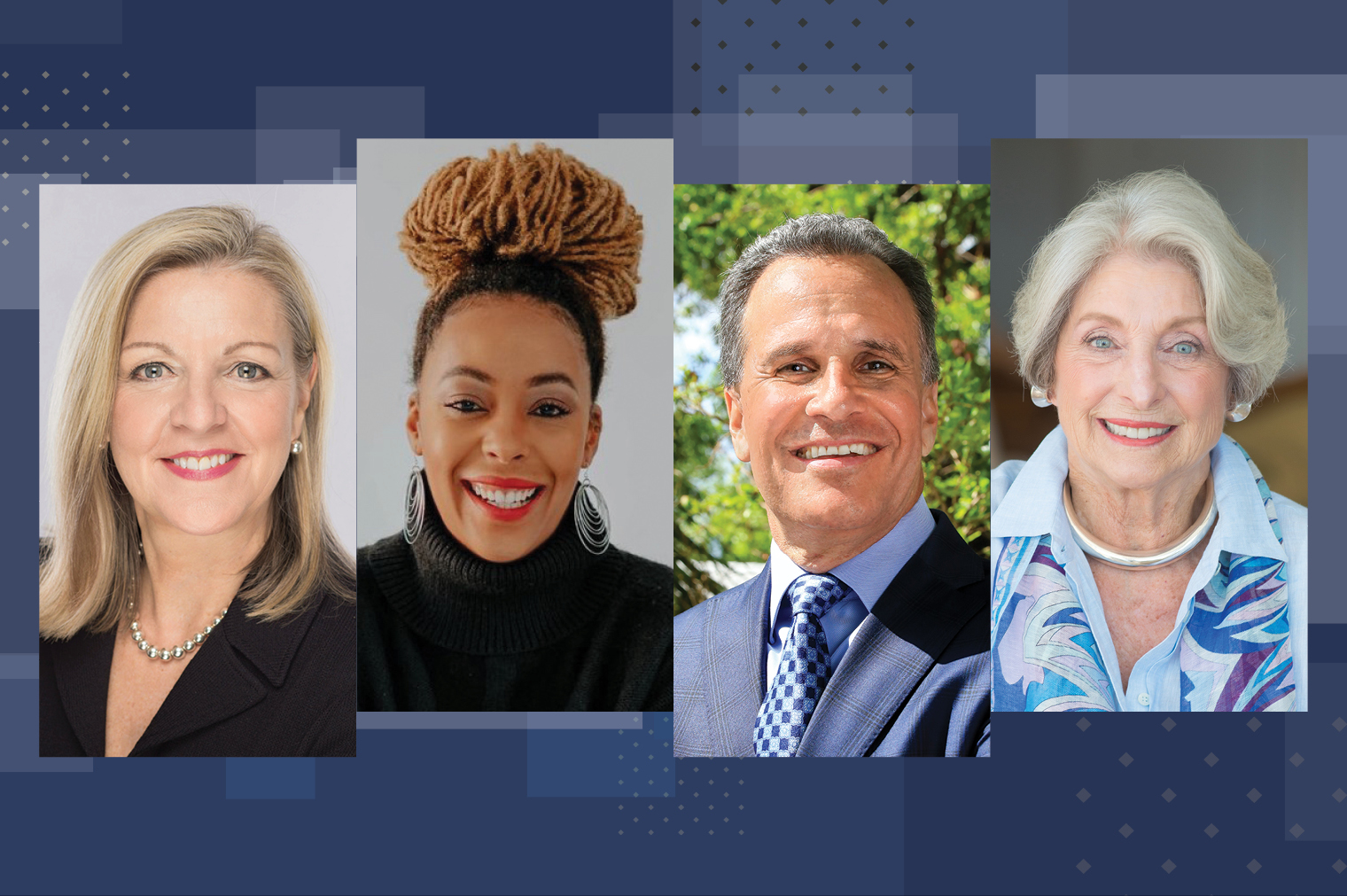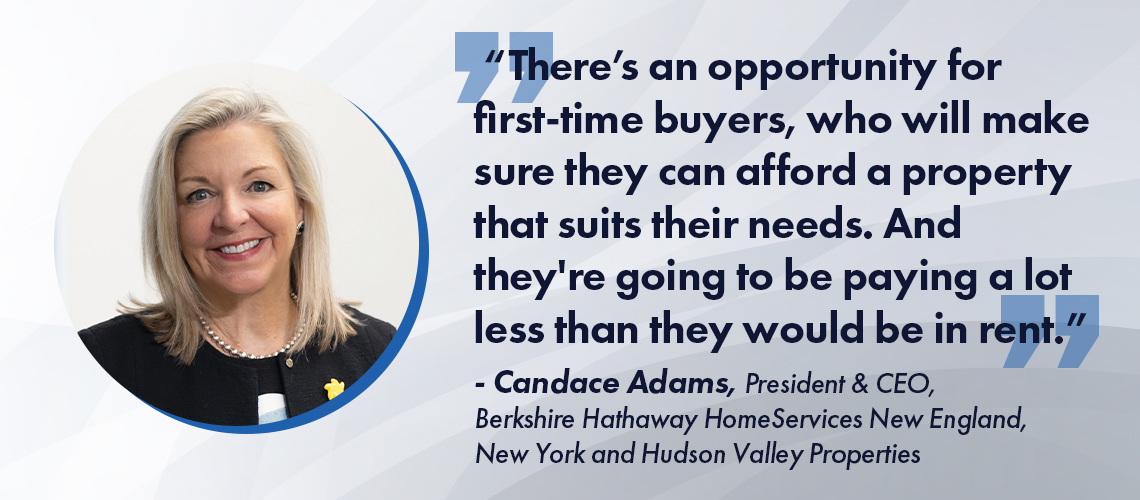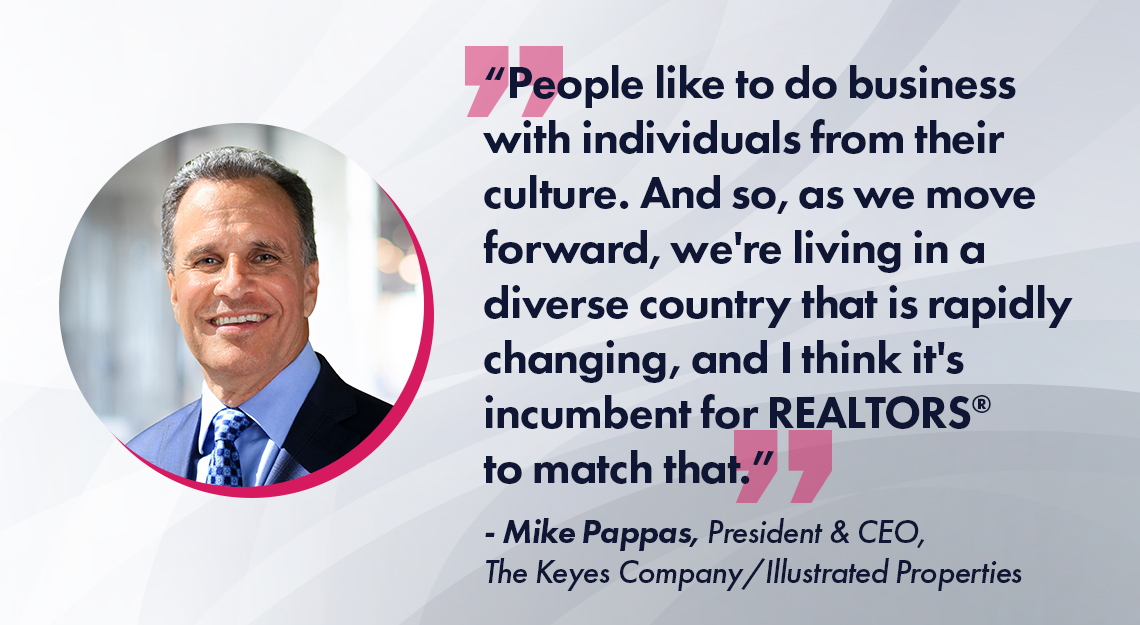
Above Left to Right: Candace Adams, Kendall Bonner, Mike Pappas, Michael Saunders
Every year is different in residential real estate, each determined by mortgage-rate fluctuations, the economy, inflation and various other factors. Just as agents must be ready to adjust, so must brokerages, always looking big-picture when making decisions. For 2023, there are unique characteristics within the residential real estate realm, but some things will likely never change, one being the American Dream of homeownership.
“I think we’re seeing a little bit more of a deliberate approach to buying real estate this year,” says Candace Adams, president and CEO of Berkshire Hathaway HomeServices New England, New York and Hudson Valley Properties. “I think the buyer will be a digital buyer, since 80% of first-time buyers are younger people looking to buy a home through the internet. They’ll be finding properties and then asking for the support and knowledge of a professional REALTOR®.”
Michael Saunders, founder and CEO of Michael Saunders & Company in Sarasota, Florida, explains that another major change in the demographics of homebuyers is more women buying properties on their own.
“They’re not simply there with their husbands to weigh in on the kitchen and the colors,” she says. “They’re buying themselves and making all the decisions. Also, we think of first-time buyers as being very young, but that isn’t always the case when you see flight from urban centers to smaller communities and to a different lifestyle. Often, in densely urban areas like New York City and Chicago, many people have rented for years, so we have to keep that in mind.”
“Homebuyers will always need us,” adds Saunders. “There is too much noise in the media. They need someone to interpret it. They want data, but no matter the age group, no matter the demographics, this is our market to own as professionals who have educated agents.”
Adapting quickly to changing demographics is something Mike Pappas, president and CEO of The Keyes Company/Illustrated Properties in Miami, Florida, feels is crucial not just for the present, but for a brokerage’s long-term viability.
“I’m a baby boomer, but we’re not the majority anymore,” he admits. “There’s Generation X, Y and Z, and now it’s even Gen Alpha that’s peeking around the corner and starting to think about buying, so we have to adapt. Social media is critical, obviously, in our communication. There are 5 million individuals turning 34, which is the prime buying age for the next few years. As we see rates lowering, who knows what’s going to happen. We think that will open up the door for more of those individuals.”
“You need to be able to communicate in the format that buyers want. And I think there’s a plethora of opportunities. There’s financing with 2-1 buydowns and adjustable-rate mortgages and jumbo-rate loans that are lower,” adds Pappas. “It’s really having the knowledge and being the resource for those new buyers coming in and communicating in the method and manner they want.”
New Buyers, Inventory and Rates
Adams notes that one advantage of new buyers entering the market now is that they weren’t trying to buy when mortgage rates were historically low about 18 months ago, so they won’t let what is now double that rate deter them from a purchase. One plus for them is that inventory is picking up, whereas in the frenzied selling of early 2021, homes for sale vanished after just a few days on the market, with bids over asking price almost always required in order to win.
“We all hope that the market will continue to soften, and at least bring more inventory to it,” she says. “There’s an opportunity for first-time buyers, who will make sure they can afford a property that suits their needs. And they’re going to be paying a lot less than they would be in rent.”
Becoming expertly attuned to the wants and desires of buyers is a must with demographics changing much more quickly than in the past.

“The focus is helping agents dig deep in terms of understanding the motivation of today’s buyers and sellers,” says Saunders. “It’s providing all the normal education necessary, whether you use a combination of live presentations and online learning or integrate great content from other trainers.”
“People are coming from farther away to buy,” she continues. “Years ago, we did so much selling to folks who were moving around a community that I used to tell agents, ‘If you don’t make three sales to that same consumer, you’re missing out and haven’t stayed in touch.’ Now, with remote work opportunities, people are speeding up their plans to move to their place of choice. And it’s getting agents to have the proper message to share with clients in the language they want. It may be face to face, it may be phone, email, text, social media; anything to build a relationship. Technology can do a lot, but relationships carry the day.”
“It’s also our job not only to educate the agents, but to influence the influencers, because more people have financial advisors,” Saunders adds. “You need to know what they’re telling their clients. And many of them are saying ‘don’t buy real estate yet.’ So you need to find a way to get to the influencers, and that can also include your local newspaper, if we have any of those left today.”
Addressing the changing homebuyer demographics with consistent social media posts is something Pappas stresses to his agents. Consistency is key, and it has been his experience that it will always reap dividends.
“People need to be communicated with consistently, and we’re rolling out a social media program of 10, 10 and five,” he explains. “We want you to engage with 10 likes every day, communicate on 10 posts and maybe share them, and then directly message five people. That would be 25 connections a day or communications. That’s 600 a month and almost 7,000 a year as you move forward. The numbers work. Out of every 100 clients or individuals, five, six or seven will sell or buy in the next year.”
Kendall Bonner, team leader of The Kendall Bonner Team at eXp Realty in Tampa, Florida, says that it is more important than ever to understand the positives and negatives in the market today, and break them down to consumers.
“It’s interesting to me because with this changing demographic, with this shifting, evolving, normalizing market, the question now becomes how to change our messaging,” she says. “How do we impact the messaging and the narrative out to the consumer? There is the negative news media, but we have rising inventory and normalizing interest rates. Brokers must be coaching agents on how they should be talking to and educating consumers about the reality of what’s happening and what that means to them as homebuyers in today’s market.”
Local Will Always Rule
Regardless of how homebuyer demographics may change for whatever reason, one thing will always be true: Residential real estate is a local business first, and will remain so.
“Geographically, things are very different in this country, and when you listen to the national news, you’re hearing a broad perspective, but real estate is still local,” insists Adams. “So, first and foremost, we need to make sure we’re in constant contact with our clients. And don’t consider them past clients. They are clients forever.
“Every market is different,” adds Adams. “Every market is local, and that’s the message we will continue to send. In the Northeast, we have one month of inventory, which is historically the lowest we’ve ever had. And we’ll probably not see more than three to five months in 2024 for all we know. It’s going to take a long time for us to rebuild inventory, so there is not going to be what we would call a balanced market. We still have a huge buyer demand, so we have to be careful not to listen to the negative national news.”
Saunders agrees, and emphasizes that it doesn’t particularly matter where the market is, how high or low the mortgage rates are, or what the inventory level is wherever agents and brokers happen to work. When a client is ready to buy a home, that’s when they should buy a home.
“Giving the consumer the confidence to buy is the agent’s job,” she says. “This really isn’t a softening market, it’s a shifting market. It’s a changing market. It’s a normalizing market. We all loved 2017, ‘18, ‘19, ‘20. You can use graphs showing the sales activity in those years. You just have to take the frenzy of pandemic buying out of that equation. It’s having the right mindset and giving people the confidence to know that there is no bad time to buy. If it’s the right time for them, then it’s the right time to buy.”
To that end, Pappas favors using numbers and statistics as part of his team’s presentations to prospective clients. Opinions can vary on everything, unlike proven figures that tell a very precise story. And social media platforms are the perfect purveyors of such information.
“Facts and information matter, and the REALTORS® who know the data of their local market can communicate it in a social media post,” he says. “There are so many good ways and different methods to package the information and put it out. Only 15% of the market bought in 2020, 2021 or even 2022, while 80% of the market bought before the pandemic, so those people are in the money. If you’ve owned your home before 2019 or 2018, you’ve seen a 30% – 40% price appreciation. It may be a good time to sell right now, so utilize the information and accentuate the positives in this market.”
“The iBuyers are gone,” adds Pappas. “The tech people have all crashed and burned, and it has come back to a REALTORS® market because we know that service matters and experience matters. It’s such a complex deal with emotions and selling and distress and divorce and death and all of the vicissitudes of life, and so we can move forward with confidence. In 2024, 2025, 2026, those individuals that bought in 2023 are going to be very happy.”
Diversity and Demographics
The homebuyer demographic is changing in age, education, lifestyle, life status and more, notes Bonner. “It is important to recognize the diversity of the consumer,” she says, “how it is relevant to the broker and in what ways a broker can embrace diversity in order to better serve the homebuying community.”

Adams expounds on that point, asserting that “diversity is something that should be at the forefront for every single one of us when we think about the future. We can totally impact diversity by attracting talent from underrepresented groups in the real estate industry. We want to make sure that we have a diverse agent population first and foremost, and then provide the solutions and a path to homeownership for people who never thought they could own a home.”
“Many of our clients are buying a home for the first time, and their entire generational family has never owned property,” she continues. “We want to help give them that opportunity. It’s the most exciting thing we can do.”
Pappas lives and works in Miami, Florida, which has a very diverse population, so he’s made sure his company can serve it in every way.
“We say we like living in Miami because it’s so close to the United States,” he says with a smile. “It’s probably one of the most diverse cities in the world, let alone in the U.S. And what we found is that people like to do business with individuals from their culture, and so as we move forward, we’re living in a diverse country that is rapidly changing, and I think it’s incumbent for REALTORS® to match that.
“We’re going to see a continuation of lead-to-close and post-close systems and platforms to be able to communicate and have conversations with clients and to streamline that process through the mortgage, the insurance, the property management and through the title, and probably even moving into the home repair,” adds Pappas. “So a full-service, lifetime relationship with the consumer is the future for the REALTOR®.”



